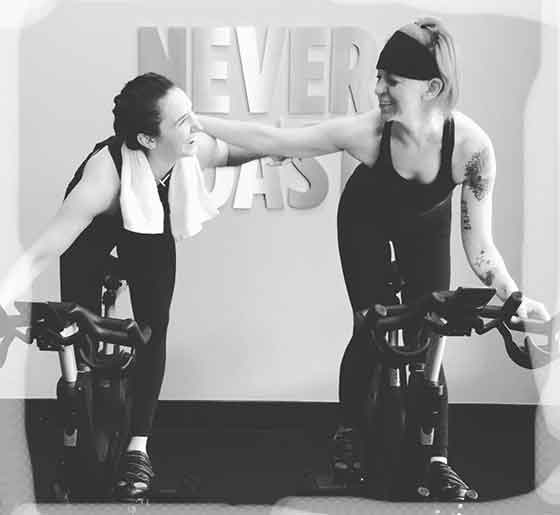 Rhythm Riding and Safety for Riders AND Instructors
Rhythm Riding and Safety for Riders AND Instructors
Rhythm riding: it’s fun, it’s challenging, and it seems to be the most popular trend in the Indoor Cycling world at the moment. I’m going to dive into the subject of rhythm riding and tips for navigating it as a rider and as an instructor.
What is Rhythm riding?
The short answer is that it’s riding to the rhythm (beat) of the music. Either your right leg or your left leg matches the down beat of whatever song is playing in the ride. Most cycle classes incorporate rhythm riding in its most simple form as humans are innately rhythmic creatures. The beat of the music in a cycle class also provides stability within the body.
The more complicated, detailed answer, is that rhythm riding is a fun, challenging way to ride an indoor cycling class that includes sequences of choreography designed to improve fitness, core strength, and build a sense of togetherness/community.
If done well, I believe that rhythm riding can be fun for everyone and anyone. There is a lot of responsibility placed on both the rider AND the instructor to accomplish this.
Simple characteristics of a rhythm ride:
-Synchronization and mirror imaging: The instructor will move in the direction that mirrors the riders, so that everyone moves as one class.
-choreography: The instructor will cue and demonstrate movements either in the saddle or out of the saddle that involve the arms and/or the torso, usually performed in 2, 4, 8, 16, 32 or more counts of music. An example of choreography is the very popular tap back move, in which the rider moves back and forth over the saddle to the beat of the music.
-Lead leg (synchronization continued): the downstroke of the leg that matches the down beat of the song. The instructor will cue either the right or left leg at any given time.

Alicia Miller
Benefits of a rhythm ride:
-Improved core and lat strength. Hidden in every piece of choreography is core work! A lot of moves also involve your latissimus dorsi muscles (my favorite muscle aka your lats or pull down muscles. Challenging moves out of the saddle force the rider to use these muscles to stabilize their bodies, and there’s just no getting around that.
-Lower stress levels and mood improvement. It’s hard to be in a cycle class where you look around and EVERYONE is riding in perfect sync with each other and NOT smile! It’s a magical moment that is created so many times in rhythm rides. Many people gravitate towards these rides just to experience that feeling of togetherness with their fellow riders.
-Improved muscle control. Being able to ride on the left or right leg to the beat on command demonstrates muscle control and body awareness. Think of it as similar to how doing daily crossword puzzles improves brain function, except for your muscles !

The down side to rhythm riding:
-Exclusivity.
There have been studios known to kick people out of the front row if they’re not riding “well enough.” There can be a dark culture of exclusivity within rhythm riding. The idea that you’re only welcome if you nail 100% of the moves 100% of the time is wrong and should not be perpetuated by any instructor or any studio. Furthermore, you can be in the most positive, supportive rhythm ride ever andstill feel discouraged if you can’t quite find the beat of the music or if you mess up some choreography.
-Higher possibility of injury.
When I mentioned earlier that a lot of responsibility rests on the rider AND the instructor, this is what I’m talking about. Sometimes sequences out of the saddle are performed at very high speeds which can cause injuries to your back, shoulders, knees or more. It is the instructors’ responsibility to not teach outside of the physical abilities of their rides, and it is the riders’ responsibility to move with care and with control.
Riders
Remember the first time you took a rhythm ride after you’d been taking traditional indoor cycle classes? Was it confusing? Challenging? Did you get lost? Was the instructor supportive? A lot of the answers to these questions might determine whether you return to a rhythm ride or simply stick to traditional Indoor Cycling. Here are some rhythm riding tips and reminders!
-its okay to feel lost!
Not every sequence will be easy and sometimes your oxygen-deprived brain won’t be able to understand a cue. Enjoy the music and give yourself grace. This is supposed to be fun!
-choreography should never cause pain.
If you’re doing a move and something doesn’t feel right in your back, shoulders, or knees…stop immediately. Ride in the saddle, take a break, then rejoin the class when it feels right.
-Pull up on the pedals just as much as you push down.
A secret to riding stronger and faster has a lot to do with the UPWARD motion of your pedal stroke (Upstroke). Pull up with the backs of your legs (hamstrings) and eliminate a lot of the bounce in your body. When you’re riding out of the saddle, squat a little lower, bend your knees and utilize your hamstrings. This is a GAME CHANGER for many riders who tend to lose speed out of the saddle. Take some of the pressure off of your quads and share the work with the backs of your legs. Your body will thank you.
-A toxic environment is not normal and doesn’t deserve your business.
If in any way an instructor is making you feel not included or if you’re feeling like a failure in their class, give them that feedback. If you don’t feel comfortable, tell a manager. If you don’t want to do that, then not returning to the class is the best option. There should be a studio out there that makes you feel welcome in a rhythm ride regardless of your ability, age, or fitness level.
Instructors
There’s nothing better than looking out and seeing everyone nailing that choreography. But what happens if there’s trouble in paradise? Here are some rhythm riding tips for instructors!
-Just because it looks cool doesn’t necessarily mean you should do it.
Your adrenaline is pumping and you’re probably riding with less resistance than your class in order to give clear instruction. I’m sure you look awesome doing that tap back/body roll combo at 130 rpm, but look at your riders. Can they keep up? Maybe choose a slower tempo for the same combo to ensure that most people can feel included and successful performing it.
-Be prepared to change it up on the fly.
Maybe you planned a crazy move and the riders just aren’t getting it. My opinion is to always meet riders where they are , change it up if you have to, and make them feel successful. It’s not always about teaching the hardest, most insane class.
-Don’t stress out if some riders are skipping the choreography and doing their own thing.
Let them be. They’re paying for the class too. Let them ride!
-Don’t ride the entire class on the right (or left) lead leg.
Would you do a strength workout and only do bicep curls with your right arm? This may be an unpopular statement to make but it’s a logical one. Give the riders time riding on BOTH legs and teach them muscle control and body awareness. You can change halfway through a song or halfway through a ride. Play with it! But remember that it will help prevent fatigue in one leg and it will also discourage riders from favoring one leg over another.
-It’s ok to mess up, and own it!
Riders know that this is a physically and mentally hard class to teach. Don’t beat yourself up if you don’t get everything just right, Keep a light heart and move on, and the riders will love you more for your humanity.
-Cue form corrections just as much as you cue choreography.
Riders cannot perform a move without stabilizing their bodies. Keep them safe by giving them cues about pulling their elbows in, using their upstroke, not rounding their spines, and doing every move from their core.

In Summary
Rhythm rides can be done safely for all fitness levels with the right attitude and instruction. Riders and Instructors: be safe, have fun, and enjoy those rhythm rides!

About the Author: Alicia Miller is a Canadian indoor cycling instructor living in Seattle, WA. She has over 10 years of experience instructing, 7 years of experience training instructors, and is a former Flywheel Master Instructor and Trainer.


